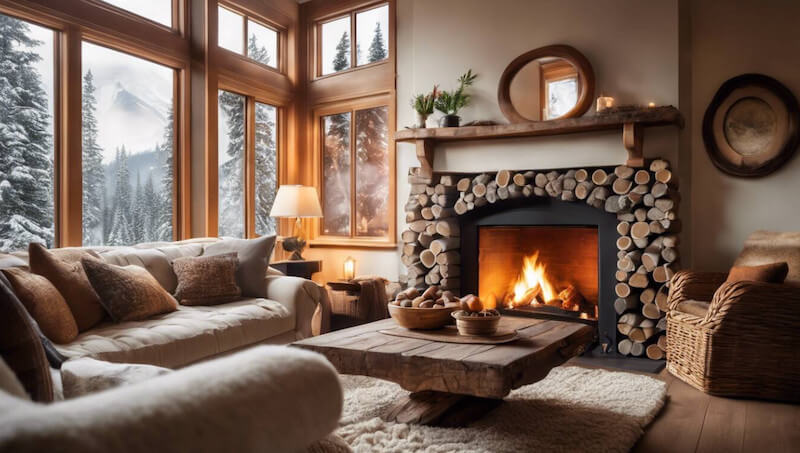Just imagine enjoying a cosy and energy efficient heating experience on a chilly winter night, all without the need to crank up your heating system! Yes, it’s possible. Ditch the old-school thinking and the sky-high heating bills – in today’s blog post, we’re going to reveal some innovative ways to heat your home efficiently without touching that thermostat! From ingenious interior design tricks to leveraging the power of infrared technology, let’s take a smarter approach this winter for warmth.
Our website provides a comprehensive list of effective tips for keeping your house warm without relying solely on turning up the heat. These tips include dressing in layers, insulating your body, using kitchen appliances strategically, enjoying hot meals and beverages, and plenty more. Implementing these tips will help you maintain a cosy and comfortable home environment while reducing your reliance on heating systems.
Tips to Keeping Your Home Warm
Insulating Your House
Using Window and Door Draught Avoiders
Investing in Insulator Curtains
Maximising Natural Heat Generation
Dressing for Warmth without the Heater
Insulating Against Chilly Floors
Minimising Energy Use With Infrared heaters
Insulating Your House
When it comes to keeping your house warm in the winter without relying solely on cranking up the heat, one of the most effective strategies is insulating your house. Proper insulation helps to minimise heat loss and prevents cold air from seeping in. This can significantly reduce both your heating bills and energy consumption!
While the idea of insulating your house sounds like a promising solution to combat winter chills, the reality is that many homeowners may find it challenging or impractical to undertake such measures.
Whether it’s due to budget constraints, rental agreements, or structural limitations, not everyone can easily enhance their home insulation.
Upgrading Window Quality
When exploring practical and minimally intrusive methods to elevate your home’s insulation, a noteworthy strategy is to focus on upgrading your windows. This approach stands out as one of the least disruptive yet highly effective ways to enhance thermal efficiency.
Consider opting for advanced window solutions that come equipped with at least two layers of glass or incorporate a low-emissivity (low-e) coating. These technological advancements are designed to act as barriers against heat loss, thereby offering a more energy-efficient solution without necessitating major structural changes to your home.
Benefits of Double-Layered Windows: Windows with at least two layers provide enhanced insulation by creating an additional air pocket between the layers. This trapped air acts as an insulating barrier, minimising the transfer of heat between the interior and exterior of your home. The result is a more stable and comfortable indoor environment, reducing the strain on your heating system.
Low-E Coating for Advanced Thermal Efficiency: Opting for windows with a low-e coating adds another layer of sophistication to your insulation strategy. This thin, virtually invisible coating is designed to reflect infrared heat, keeping your home warmer in the winter by preventing heat from escaping. Simultaneously, it helps maintain a cooler interior during the summer by reflecting the sun’s rays.
Inner Wall Insulation
Another option worth considering, although more intrusive, is inner wall insulation. While it requires internal work within the home, adding insulation to the inner walls can provide substantial improvements in heat retention. However, this option is more suitable for those willing to invest in a comprehensive solution, as it involves some disruption to the living space.
While acknowledging these challenges, let’s explore alternative and more realistic approaches to keep your house warm during the colder months. While insulation is undoubtedly effective, there are practical and accessible strategies that don’t require major renovations or significant investments.
So, if the prospect of insulating your entire home seems daunting, fear not! We’ve got you covered with practical tips that anyone can implement to create a cosy haven without cranking up the heat!
Using Window and Door Draught Avoiders
Windows and doors are common culprits for letting cold air into your home. To combat this issue, you can use draught avoiders, often called draught stoppers or draught snakes. These simple yet effective devices act as barriers at the bottom of windows and doors to prevent drafts from entering.

Imagine a chilly evening where you’re relaxing on your couch near a window. Despite the heating system working diligently, you feel a continuous flow of cold air sneaking in through gaps at the bottom of the window. By placing a draught avoider along the base of the window frame, you create a barrier that stops cold air from entering while retaining the warmth inside.
Draught avoiders can be purchased at hardware stores or easily made at home using materials like fabric and fillings such as rice or foam. Simply measure the width of your windows and doors and sew together a fabric tube filled with your chosen insulating material. Then place them snugly against the bottom edges of your doors or windows to create a barrier against draughts.
Remember, it’s crucial to use draught avoiders consistently and ensure they are properly aligned to provide maximum efficiency.
Investing in Insulator Curtains
One effective way to keep your house warm during the winter without turning up the heat is by investing in insulator curtains. These specially designed curtains are made with thermal lining that helps to trap heat inside your home while blocking out cold drafts from windows. Insulator curtains act as a barrier, minimising heat loss through windows by creating an additional layer of insulation.
For example, during the day when the sun is shining, you can open your curtains to allow sunlight to naturally warm up your home. Then, as the temperature drops in the evening, close your insulator curtains to retain the warmth inside. This not only helps to keep your rooms cosy but can also reduce heating costs by conserving energy.
Did you know?
Approximately 30% of the heating energy in a home escapes through its windows, while during cooling seasons, around 76% of the sunlight that reaches standard double-pane windows transforms into heat. [R]
It’s important to choose the right type of insulator curtains for maximum effectiveness. Look for curtains made with heavyweight fabrics and thermal lining materials such as flannel, fleece, or suede.
Note: Please be aware that insulator curtains have certain limitations. For instance, in regions with cold climates and single-glazed windows, these curtains may restrict their ability to retain heat effectively within the house. In this specific scenario, a more optimal solution would involve the installation of double-glazed windows throughout the house, complemented by the use of insulator curtains.
- Insulator curtains are an effective and energy-saving solution for keeping your house warm during the winter. These curtains are made with thermal lining that traps heat inside while blocking out cold drafts. Opening the curtains during the day allows sunlight to naturally warm up your home, while closing them in the evening retains the warmth. Choosing heavyweight fabrics and thermal lining materials, as well as curtains with multiple layers or designed for thermal insulation, will maximise their effectiveness. Additionally, consider using natural heat generation methods to further keep your house warm.
Maximising Natural Heat Generation
During winter, there are various ways you can make use of natural heat sources to keep your house warm without relying solely on your heating system. One effective method is harnessing the heat generated from cooking and baking.
When you use your oven or stove for cooking, it generates heat that can escape into your kitchen and surrounding areas. To make the most of this heat, leave the oven door open after baking (ensuring safety precautions) so that hot air circulates into the room. The residual heat from cooking can contribute significantly to raising the temperature indoors.
The kitchen proves to be an excellent retreat during breakfast, lunch, and dinner hours, especially when doors are closed to contain and preserve the warmth within, preventing it from dissipating throughout the rest of the house!
Dressing for Warm Comfort without the Heater
The way you dress plays a significant role in maintaining warmth indoors during chilly winter days. Layering your clothing is key to regulating body temperature effectively. Remember, it’s all about finding the right balance in your clothing layers. You want to avoid overheating, which can lead to excessive sweating and discomfort. By dressing appropriately for winter weather, you can achieve a cosy and comfortable environment without solely relying on the heater.

Start with a thin base layer made of moisture-wicking material to keep perspiration away from your skin. Add a middle layer of thermal or wool garments to provide insulation and trap body heat. Finally, top it off with a cosy outer layer to shield yourself from cold drafts.
Imagine dressing like an onion – each layer serves a purpose and contributes to overall warmth and comfort. Just like how an onion has multiple layers that protect it from the environment, layering your clothing during winter helps shield you from the cold and retain heat within.
Another effective way to stay warm is by wearing thick socks or slippers to keep your feet cosy. Feet are quite sensitive to temperature and can quickly make you feel cold if they’re not adequately insulated. So, don’t underestimate the power of warm, comfortable footwear in maintaining overall body warmth.
Insulating Against Chilly Floors
In our pursuit of creating a warm and inviting home during the winter months, let’s not overlook the transformative power of area rugs. Particularly beneficial for homes with cold, hard floors such as hardwood or tile surfaces, strategically placing area rugs can significantly contribute to your comfort and the overall warmth of your living spaces.

Consider this simple yet effective strategy: add area rugs to spaces where cold floors might compromise your comfort. Cold floors, especially in rooms with hard surfaces, can detract from the cosiness of your home. By strategically placing area rugs in these areas, you’re not only introducing a touch of style but also providing an additional layer of insulation. Rugs act as a protective barrier between your feet and the chilly floor, offering a warm and inviting surface that enhances the comfort of your living spaces.
Place area rugs in key areas where you frequently spend time, such as the living room or bedroom. Not only do they provide insulation, but they also act as a visual anchor, defining specific areas within a room. This strategic placement ensures that the warmth is not only felt underfoot but also extends to create inviting, well-defined spaces…
However, we also often wear slippers to keep our feet warm and for the convenience of quick movements around the house. Nonetheless, this decision can lead to a conflict with rugs, creating challenges in maintaining cleanliness as dirt may be transferred from slippers to the rug. This underscores the ongoing struggle to find a balance between comfort and the overall aesthetic and tidiness of your living space.
Minimising Energy Use With Infrared heaters
As we conclude our exploration of innovative ways to keep your house warm without solely relying on cranking up the heat, it’s crucial to acknowledge the role of infrared heaters. While the use of these heaters does involve electrical consumption, a potential contradiction to the article’s title, they offer a unique advantage—zonal heating.
For those equipped with infrared heaters, the concept of zonal heating becomes particularly beneficial, especially when spending extended periods alone in the house or concentrating activities in a specific room. In practice, this means you can dial down your central heating, avoiding the need to warm up the entire house. Instead, you can strategically deploy infrared heating to focus warmth precisely where you need it most.
Moreover, by turning down your central heating, you not only contribute to a more energy-efficient approach but also effectively save on heating costs. This dual benefit allows you to strike a balance between comfort and economy, ensuring that you stay warm and cosy without unnecessary expenses.
Should I use a programmable thermostat to regulate temperature?
These advanced thermostats allow you to set different temperature levels for different times of the day, ensuring optimal comfort and energy efficiency. By programming your thermostat to lower the temperature when you’re away or asleep and raise it when you’re at home, you can save on heating costs without sacrificing warmth. Additionally, some programmable thermostats even have smart features that learn your preferences over time and adjust accordingly, making them even more convenient and efficient.
How do I identify and fix cold spots in different areas of my house?
Identifying and fixing cold spots in your house can greatly improve its overall warmth and comfort. To begin, carefully inspect each room for any noticeable temperature differences. Use a handheld infrared thermometer to measure the surface temperature of walls, windows, and floors. If you detect a significant temperature drop in certain areas, it could indicate air leaks or insufficient insulation. Start by sealing any gaps or cracks around windows and doors with weatherstripping or caulk. Next, consider adding insulation to the walls or attic if needed. Additionally, installing thermal curtains or blinds can help regulate indoor temperatures by preventing heat loss through windows. Lastly, using draft stoppers at the bottom of doors can effectively block cold air from entering your rooms.
What type of flooring is best for retaining heat in a house?
For optimal heat retention, choose flooring with high thermal conductivity. Cork flooring, known for excellent insulation and heat retention, creates a cozy and energy-efficient space. Alternatively, natural wood absorbs heat effectively. Carpets offer a budget-friendly option for warm floors.
Did you know? Effectively insulating your ground floor can significantly enhance the warmth of your property. According to the Energy Saving Trust, quality insulation beneath your feet could potentially save you over £85 annually.
